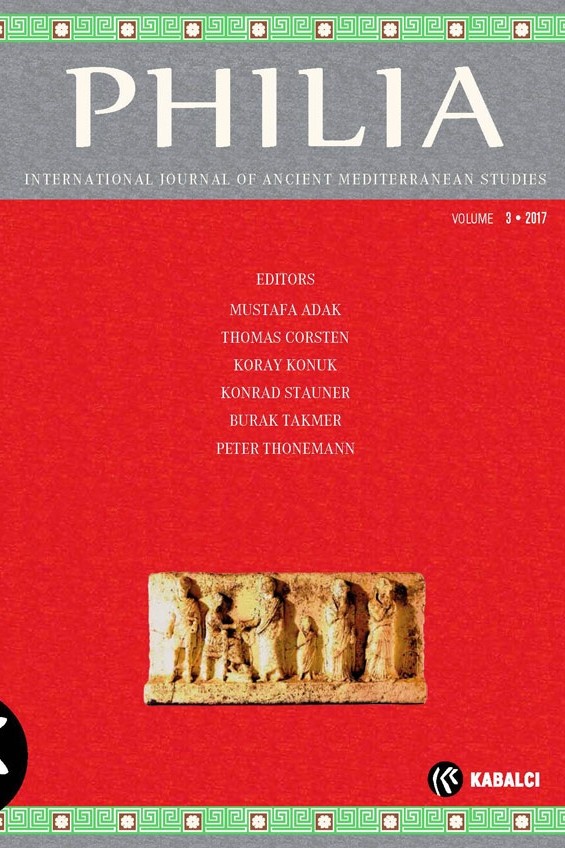Dünyanın En Eski Şanzıman Tasviri. Phrygia Hierapolisi’nden «Daedalos» ve Mucit Ammianos
Hierapolis kuzey nekropol sahasında İ.S. 3. yy.a ait traverten bir lahit
ele geçmiştir. Lahit kapağının üzerinde yer alan yazıtta mezar sahibi Marcus
Aurelius Ammianos kendisini «becerikli mucit» ve Daidalos olarak tanıtmaktadır.
Kapağın yan yüzüne yazıtın arasına işlenen bir kabartma mezar sahibinin hangi
konuda becerikli olduğunu göstermektedir: Ammianos su gücüyle çalışan ve mermer
kalıpları kesmekte kullanılan iki testereli bir makine icat etmiştir. Yazar
burada daha önce iki yerde tanıttığı bu taş kesme makinesinin bazı teknik
özelliklerine değinerek 18. yüzyılda Schwerin’de icat edilen testere ile aynı
donanıma sahip olduğunu vurgulamaktadır. Buna göre su çarkı aracılığıyla değirmen
ekseni önce bir dişli çarkı çalıştırmaktaydı. Şanzıman görevi yapan bu dişli
çark hareketi dikey eksene aktaran başka bir çark ile bağlantılıydı. Bu çark
ise sonlarına iki testere bağlanmış iki itme çubuğunu harekete geçiriyordu.
Ephesos ve Gerasa’da yakın zamanda tespit edilen testere makinelerinin de aynı
yöntemle işlediği varsayılmaktadır.
Anahtar Kelimeler:
Hierapolis, Ammianos, güç aktarımı, su çarkı, şanzıman, çift taş kesme testeresi
Die älteste Getriebedarstellung der Welt. Ammianos, der „Daedalos“ und Erfinder aus Hierapolis in Phrygien
There was a huge demand for marble slabs in Antiquity in order to cover the
floors and to face the walls in rich villas and especially in baths. Only some
literary sources yet give information on its production. The archaeological
finds of two marble workshops in Gerasa and Ephesus provided the first insight
into the production process in the Byzantine period. The decrypting of a relief
from Hierapolis in Phrygia (2nd half of the 3rd century AD) has made it
possible to see technical sophistication with which this problem was attended
to in Antiquity: The transmission of power from a waterwheel on a double-stone
saw with the aid of gears, a crankshaft and pushrods is finely depicted in the
relief. This is the first pictorial representation of a gear drive in the
history of technology.
Keywords:
Hierapolis, Ammianos, waterwheel, gear drive, double-stone saw,
___
- Grewe 2009 K. Grewe, Die Reliefdarstellung einer antiken Steinsäge aus Hierapolis in Phrygien und ihre Bedeutung für die Technikgeschichte. in: M. Bachmann (Hrsg.), Bautechnik im antiken und vorantiken Kleinasien. Veröffent¬lichungen. d. Deutschen Archäologischen Instituts Istanbul, BYZAS 9, 2009, 429–454.
- Grewe 2014 K. Grewe, Aquädukte: Wasser für Roms Städte, Rheinbach 2014.
- Sturm 1815 L. C. Sturm, Vollständige Mühlen-Baukunst (Augsburg 1718, 41778, 51815).
- ISSN: 2149-505X
- Başlangıç: 2015
- Yayıncı: Kabalcı Yayıncılık
Sayıdaki Diğer Makaleler
Antalya Müzesi’nden Yeni Adak ve Mezar Yazıtları
Bithynia’da «Ünlü Cassius’lar»
Karasis Kalesi Hakkında Bir Yorum
Murat DURUKAN, Ulus TEPEBAŞ, Muzaffer YILMAZ
Antik Literatürden Örneklerle Akdeniz Dünyasında Kybele Kültü
Nikaia’dan, Istampajları Köln’deki Arşivde Bulunan İki Mezar Epigramı
Küçük Asya’da Diadokhoi Savaşları: Kardia’lı Eumenes’in Savaş Stratejisi
Dünyanın En Eski Şanzıman Tasviri. Phrygia Hierapolisi’nden «Daedalos» ve Mucit Ammianos
